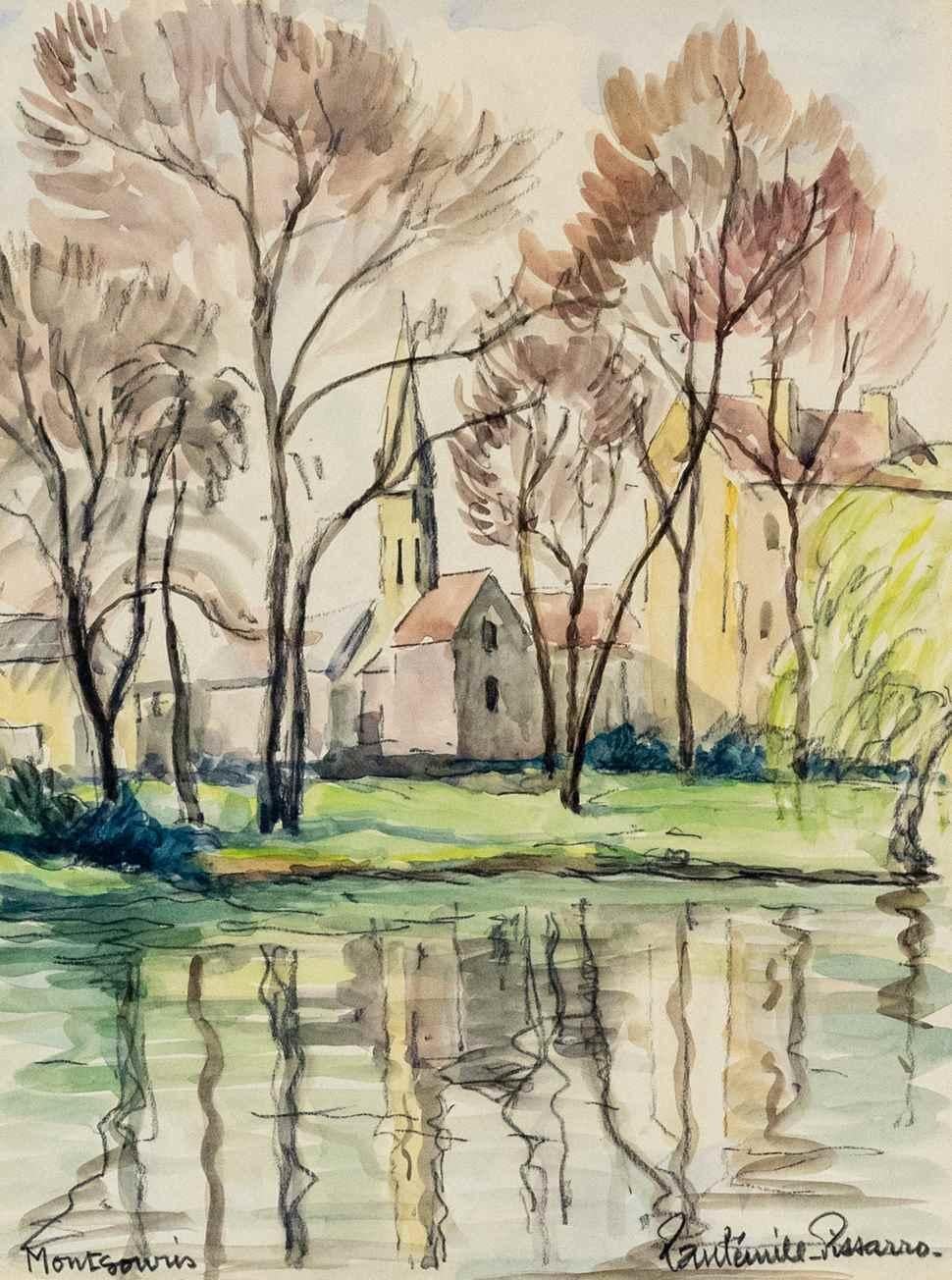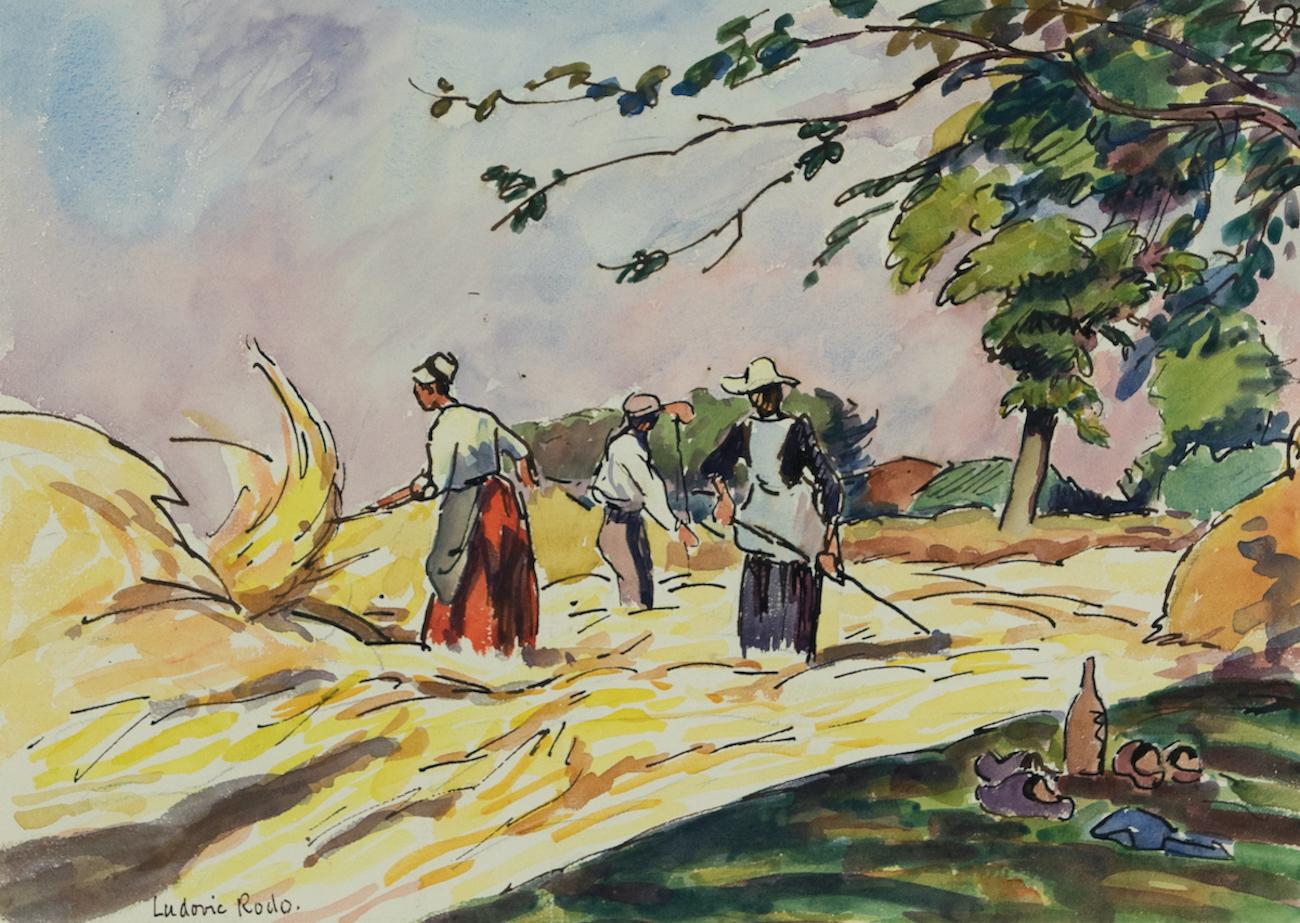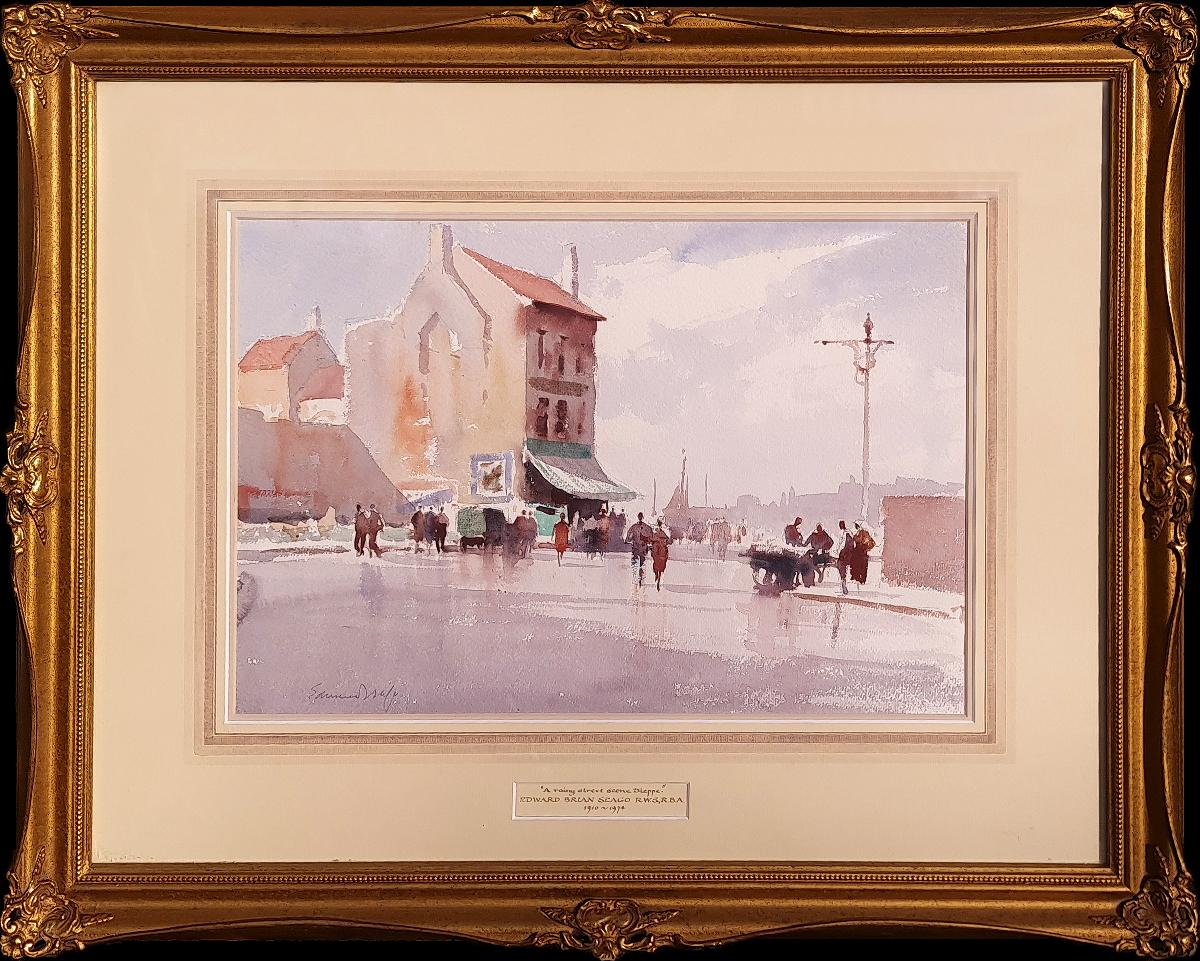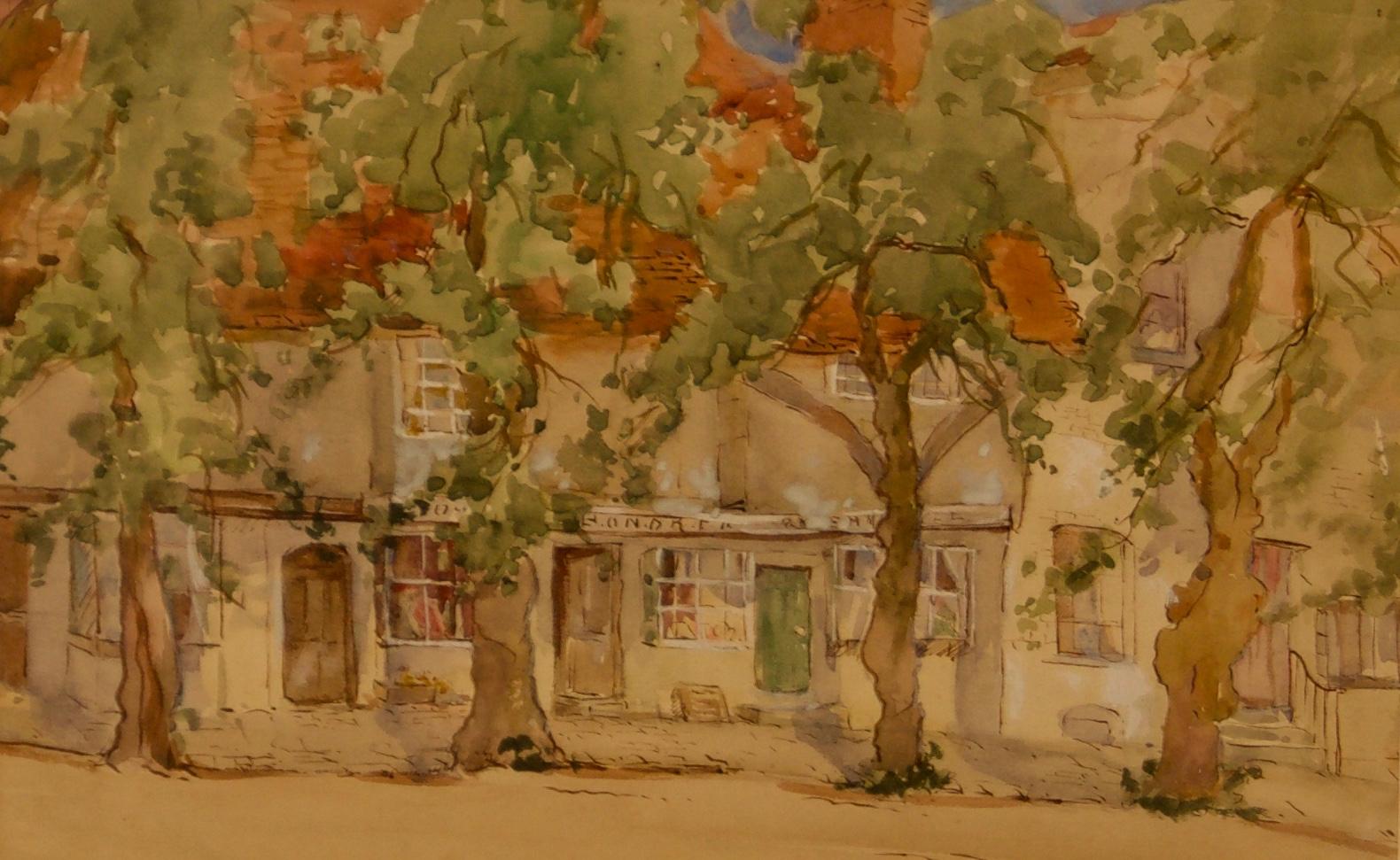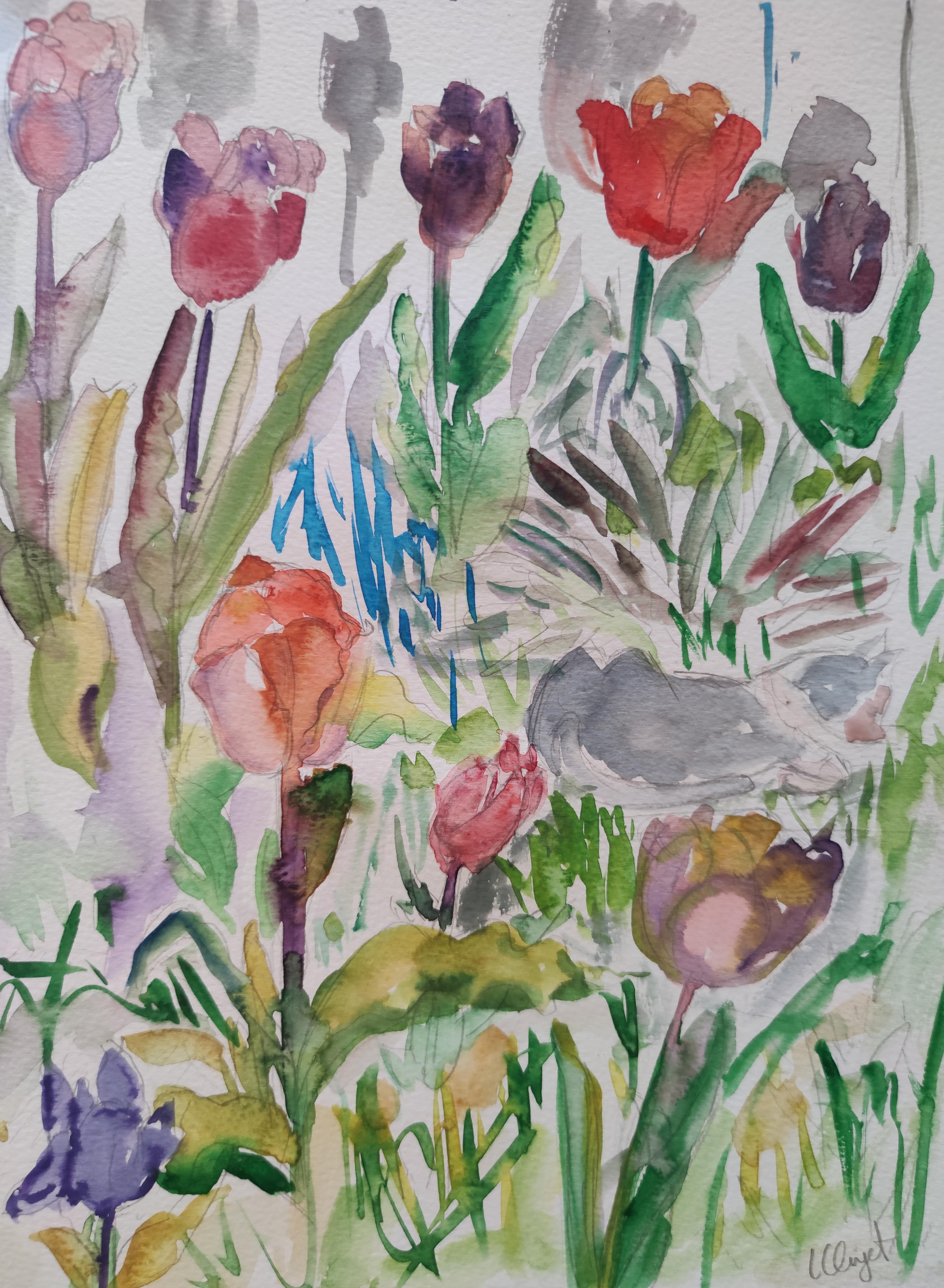Items Similar to Le Défilé Royal (Illustration for Voyage au Pays des Pommes) by Lucien Pissarro
Want more images or videos?
Request additional images or videos from the seller
1 of 6
Lucien PissarroLe Défilé Royal (Illustration for Voyage au Pays des Pommes) by Lucien Pissarro
About the Item
Le Défilé Royal (Illustration for Voyage au Pays des Pommes) by Lucien Pissarro (1863-1944)
Watercolour on paper
22.5 x 26 cm (8 ⅞ x 10 ¼ inches)
Signed lower left with monogram
This work is accompanied by a letter of authenticity from Colin Harrison, Senior Curator of European Art at the Ashmolean Museum, Oxford.
Provenance
Mr Ian Robertson
Exhibition
London, Leicester Galleries, Memorial Exhibition of Lucien Pissarro's Work, Part II, 1947, No. 60 (catalogued as La Procession)
Artist biography
Born on the 20th February 1863, Lucien Pissarro was the eldest son of the Impressionist painter Camille Pissarro. Coached from a young age by his father and in the frequent company of figures such as Cézanne, Gauguin and Monet, it is no surprise that Lucien chose to pursue an artistic career. While he is best known as a landscape painter, Lucien was also a printmaker, wood engraver and printer of fine books, occasionally painting still lifes and portraits of his family.
Lucien first visited England in 1870 with his family when fleeing the Franco-Prussian war. It was the beginning of a great love affair with the country. He decided to move permanently to England in 1890, becoming an English citizen in 1916. Until then he had worked as a landscape painter and book illustrator in France. During this period he met and worked with painters such as Paul Signac, Georges Seurat and Vincent van Gogh. Moving simultaneously in Impressionist and Neo-Impressionist circles, Lucien exhibited Pointillist paintings with his father in the last Impressionist exhibition in 1886. In the same year he was one of the first artists to exhibit in the “Salon des Indépendants” as a Neo-Impressionist.
Despite his close relationship with his father, as revealed in their correspondence, Lucien showed remarkable independence of mind in his approach to his art. While Lucien was trained by his father, the influence the artists had on one another was reciprocal. Thanks to his relationship with Seurat and Signac, Lucien encouraged Camille to experiment with Pointillism, a characteristic of the Neo-Impressionist group.
Lucien’s move to England in 1890 allowed him greater freedom to pursue his interest in book illustration and printing. There Lucien and his wife Esther established the Éragny Press, named after the Normandy village where his family lived since 1884. The Éragny Press was principally notable for creating aesthetically pleasing books and paved the way for the development of European book art. Lucien’s illustrations for these books demonstrate his talent and command of colour.
Nevertheless, Lucien always considered painting his primary concern, particularly landscape painting. Continuing the tradition of the Impressionists, Lucien was a plein-air painter who liked to work outdoors and study the subject directly from nature. His landscapes reveal his fascination for the effects of weather and light. The contemporary art critic Frank Rutter described Lucien as a master of colour, writing in 1922: “there is no man living who has a more profound knowledge of the science of colour, or a more discriminating eye for its observation in nature.” Rutter was also struck by Lucien’s respect for his subject, nature itself: “Each canvas is wrought with a quiet perfection that conceals its art and is eloquent of the tender emotion which the loveliness of nature inspires in the artist.”
It is clear from Rutter’s praise that Lucien’s contemporaries were impressed by his combination of English and French artistic traditions. Unsurprisingly, he became associated with artistic groups that drew inspiration from the Impressionists, including the New English Art Club, with whom he exhibited in 1904, the Fitzroy Street Group in 1907 and the Camden Town Group in 1911. To his English contemporaries Lucien represented a direct link to the Impressionist Masters. His influence can be recognised in the work of British artists such as Spencer Gore, Harold Gilman and Walter Sickert, who acknowledged Lucien’s influence, writing in 1914: “Mr Pissarro, holding the exceptional position at once of an original talent, and of the pupil of his father, the authoritative depository of a mass of inherited knowledge and experience, has certainly served us as a guide.”
Since his first solo exhibition at the Carfax Gallery in May 1913, Lucien Pissarro’s work has been featured in countless exhibitions and galleries. During his lifetime Lucien donated his estate to the Ashmolean museum in Oxford, where a permanent collection of his work is still housed today. His works are featured in every major art museum in England, as well as the Musée d’Orsay in Paris, the National Gallery of Australia and many museums in the USA.
- Creator:Lucien Pissarro (1863 - 1944, French)
- Dimensions:Height: 8.86 in (22.5 cm)Width: 10.24 in (26 cm)
- Medium:
- Movement & Style:
- Period:
- Condition:
- Gallery Location:London, GB
- Reference Number:1stDibs: LU261210599922
About the Seller
5.0
Recognized Seller
These prestigious sellers are industry leaders and represent the highest echelon for item quality and design.
Platinum Seller
These expertly vetted sellers are 1stDibs' most experienced sellers and are rated highest by our customers.
Established in 1964
1stDibs seller since 2015
95 sales on 1stDibs
Typical response time: 4 hours
Associations
Society Of London Art Dealers
- ShippingRetrieving quote...Ships From: London, United Kingdom
- Return PolicyA return for this item may be initiated within 7 days of delivery.
More From This SellerView All
- Montsouris, Watercolour and charcoal on Paper by Paulémile PissarroLocated in London, GBMontsouris by Paulémile Pissarro (1884 - 1972) Watercolour and charcoal on paper 33 x 25 cm (13 x 9 ⁷/₈ inches) Signed lower right, Paulémile- Pissarro. and titled lower left Execu...Category
1930s Post-Impressionist Figurative Drawings and Watercolors
MaterialsPastel, Paper, Watercolor
- Moissonneurs à Blarimon by Ludovic-Rodo Pissarro - WatercolourBy Ludovic-Rodo PissarroLocated in London, GBMoissonneurs à Blarimon by Ludovic-Rodo Pissarro (1878-1952) Watercolour and ink on paper 26.4 x 37 cm (10 ³/₈ x 14 ⁵/₈ inches) Signed lower left, Ludovic Rodo. Executed in 1931 T...Category
1930s Post-Impressionist Landscape Drawings and Watercolors
MaterialsPaper, Ink, Watercolor
- L'Église de Morgny-Eure by Paulémile Pissarro, 1927Located in London, GBL'Église de Morgny-Eure by Paulémile Pissarro (1884 - 1972) Watercolour and black crayon on paper 31.5 x 43.5 cm (12 ³/₈ x 17 ¹/₈ inches) Signed lower right, Paulémile and dated, Mor...Category
1920s Post-Impressionist Paintings
MaterialsPaper, Watercolor
- Études sur Titu by Paulémile Pissarro - Study drawing, 1938Located in London, GBÉtudes sur Titu by Paulémile Pissarro (1884 - 1972) Watercolour and pencil on paper 33.5 x 23.6 cm (13 ¹/₄ x 9 ¹/₄ inches) Signed lower middle Paulémile-Pissarro- and inscribed upper...Category
1930s Post-Impressionist Landscape Drawings and Watercolors
MaterialsPaper, Watercolor, Pencil
- Paysage Normand, Port en Bessin by Ludovic-Rodo Pissarro, watercolour, 1914By Ludovic-Rodo PissarroLocated in London, GBPaysage Normand, Port en Bessin by Ludovic-Rodo Pissarro (1878-1952) Watercolour and ink on paper 23.5 x 30 cm (9 ¹/₄ x 11 ³/₄ inches) Signed and dated lower right, Ludovic Rodo 1914...Category
1910s Post-Impressionist Landscape Drawings and Watercolors
MaterialsPaper, Ink, Watercolor
- La Celle les Bordes by LUDOVIC-RODO PISSARRO - Post-Impressionist watercolourBy Ludovic-Rodo PissarroLocated in London, GBLa Celle les Bordes by LUDOVIC-RODO PISSARRO (1878-1952) Watercolour on paper 35 x 25 cm (13 3⁄4 x 9 7⁄8 inches) Signed lower left, Ludovic Rodo Inscribed and dated lower right, La ...Category
Early 1900s Post-Impressionist Landscape Drawings and Watercolors
MaterialsPaper, Watercolor
You May Also Like
- La Baie des Anges a Nice et le Casino 1928 gouache Palm Trees, Horse & CarriageBy Raoul DufyLocated in Rancho Santa Fe, CALa Baie des Anges a Nice et le Casino is a lovely gouache on paper from 1928. The work is fully authenticated by Fanny Guillon-Laffaille and is listed in the Raoul Dufy Catalogue Rai...Category
1920s Post-Impressionist Landscape Paintings
MaterialsGouache, Archival Paper
- A Rainy Street scene in DieppeBy Edward SeagoLocated in Belgravia, London, LondonA Rainy Street scene in Dieppe by Edward Brian Seago RBA, RWS British 1910-1974 Watercolour Paper Size: 11 x 15 inches Approximate framed size: 21 x 25 inches signed lower leftCategory
20th Century Post-Impressionist Landscape Drawings and Watercolors
MaterialsPaper, Watercolor
- South of France - Early 20th Century Impressionist Watercolour by BennettBy Sterndale BennettLocated in Watford, HertfordshireSterndale Bennett Honor 1886-1975 Watercolour artist, born in Watford, she married into the famous family noted for its composers and for its military members. As an army wife she s...Category
1920s Post-Impressionist Landscape Drawings and Watercolors
MaterialsWatercolor, Paper
- Isis with the tulipesLocated in THOMERY, FRThis delicate watercolor painting captures the serene beauty of springtime in Linda Clerget's garden. In the center of the composition sits Isis, her beloved cat, surrounded by vibra...Category
21st Century and Contemporary Fauvist Landscape Drawings and Watercolors
MaterialsWatercolor, Handmade Paper
- Concours de Chiens au Promenade by Otto EerelmanBy Otto EerelmanLocated in New Orleans, LAOtto Eerelman 1839-1926 Dutch Concours de Chiens au Promenade Watercolor on paper Signed “O. Eerelman 1904” (lower left) A tour de force watercolor by celebrated Dutch artist Otto Eerelman, one of 19th-century Europe's most popular and important animal portraitists, this charming composition captures a bustling cross-section of fashionable elites walking their equally fashionable canine companions. Eerleman takes care to render the detailed attire of his subjects, complete with plumed hats and layers of lace trim. The artist paints the plethora of pets in equally painstaking detail, capturing the nuances of each different breed represented. Eerelman mastered the art of depicting not only the dogs’ physical characteristics but also their unique expressions and personalities. His wealthy clientele would bring their pets to his home in The Hague where they would live for a period of time while having their portraits done, allowing for a remarkably true-to-life portrayal. This energetic watercolor, with its profusion of color and texture, harnesses the affluence of its subjects and the leisurely whimsy of their luxurious lives. Hailing from Groningen, Netherlands, Eerelman was dubbed the “Northern Rembrandt” during his lifetime. He received his artistic training at the Academy Minerva in Groningen, the Royal Academy of Fine Arts in Antwerp and then private lessons in the studio of the great Lawrence Alma Tadema. He successfully captured the attention of the Dutch court, particularly Princess Wilhelmina...Category
Early 20th Century Post-Impressionist Figurative Drawings and Watercolors
MaterialsPaper, Watercolor
- “Birches in Winter”By Francis Stillwell DixonLocated in Southampton, NYOriginal watercolor and gouache on archival paper of birch trees in winter along a fenced roadway with a quaint home in the background. Signed lower right. Condition is excellent. Circa 1960. The watercolor is in a solid mahogany frame under UV glass in fine condition. Overall framed measurements are 14 by 11 inches. Provenance: A East Hampton, Long Island, New York collector. Born in Queens, Long Island, NY, Impressionist landscape and seascape painter Francis Dixon studied at the Art Students League in New York City under Impressionists Frank Vincent DuMond, Cape Cod, Massachusetts artist, Charles W. Hawthorne, and modernist Robert Henri. Having a good singing voice Dixon was an Army and Navy Song Leader for the War Department during World War I. From 1915 to 1917 was living and painting in Los Angeles, Carmel and Point Lobos, California. Dixon exhibited his California paintings at Folson Galleries New York City in 1917. Dixon continued to travel and paint, visiting Bermuda in 1923 and 1925, and Europe in the mid-1920s. In the 1930s he was living on West 55th Street in Manhattan with a number of other artists. He was a member of the Allied Artists of America (NY); Connecticut Academy of Fine Arts; and the Salmagundi Club, NY. He exhibited at The Corcoran Gallery of Art, Washington, D.C. (1916); Folson Gallery (NY, 1917, solo); Society of Independent Artists (NYC, 1917-18, 1920-22, 1924); Salmagundi Club (NYC, 1917-1940, 1943, 1945); National Academy of Design (NYC, 1925); Studio Guild Galleries (NYC, 1937); Barbizon-Plaza Galleries NYC, 1939); Allied Artists of America (NYC, 1940); and Salons of America (NYC). Dixon’s solo exhibitions included Babcock Galleries (NYC, 1926 and 1927); Women's University Club...Category
1950s Post-Impressionist Landscape Drawings and Watercolors
MaterialsWatercolor, Gouache, Archival Paper

